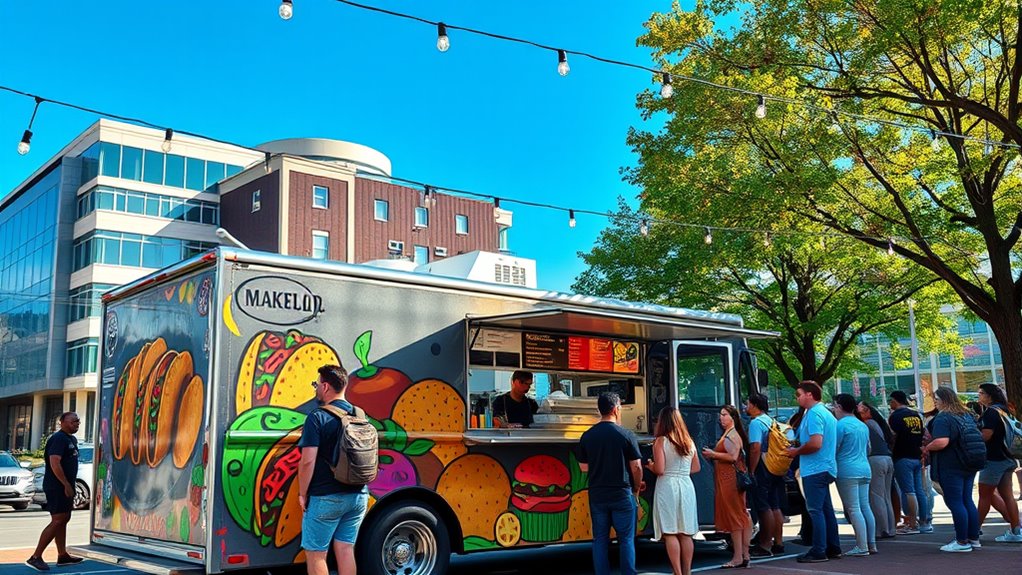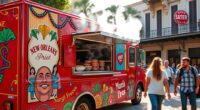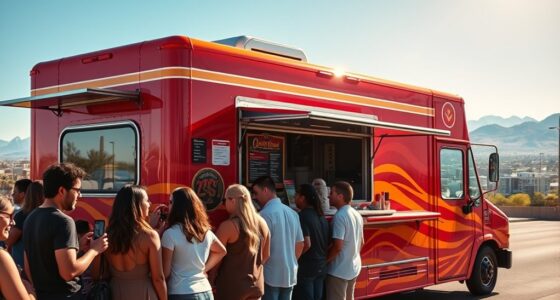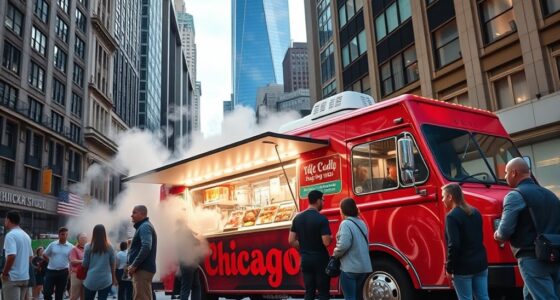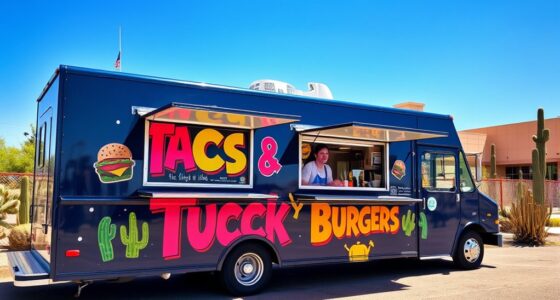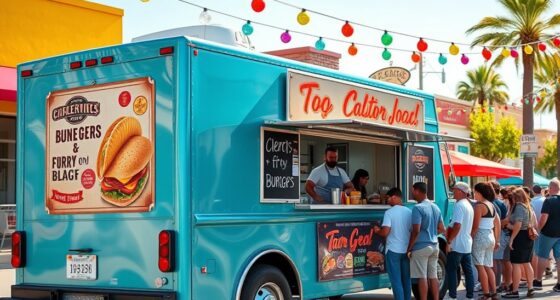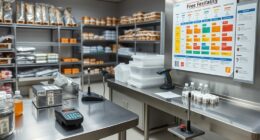To start a food truck in Arlington, TX, you need to obtain the necessary permits by submitting detailed documentation and ensuring compliance with local health and safety standards. Plan your budget, including equipment costs and insurance, and develop a menu that highlights local flavors. Use technology to streamline operations and invest in marketing to grow your presence in Arlington’s vibrant food scene. Keep exploring to discover the key steps that will help your food truck succeed.
Key Takeaways
- Obtain necessary permits and licenses through Arlington’s online portals, ensuring compliance with health, safety, and zoning regulations.
- Develop a detailed business plan including budgeting for equipment, insurance, and permits, considering local grants and funding options.
- Design a menu featuring local flavors, control costs with portion analysis, and implement inventory management tools for efficient operations.
- Create a strong brand with eye-catching truck design, consistent branding, and a social media strategy to attract and engage customers.
- Research Arlington’s food scene, identify popular vending zones, and plan for growth through community partnerships and seasonal promotions.
Starting With a Food Truck Permit
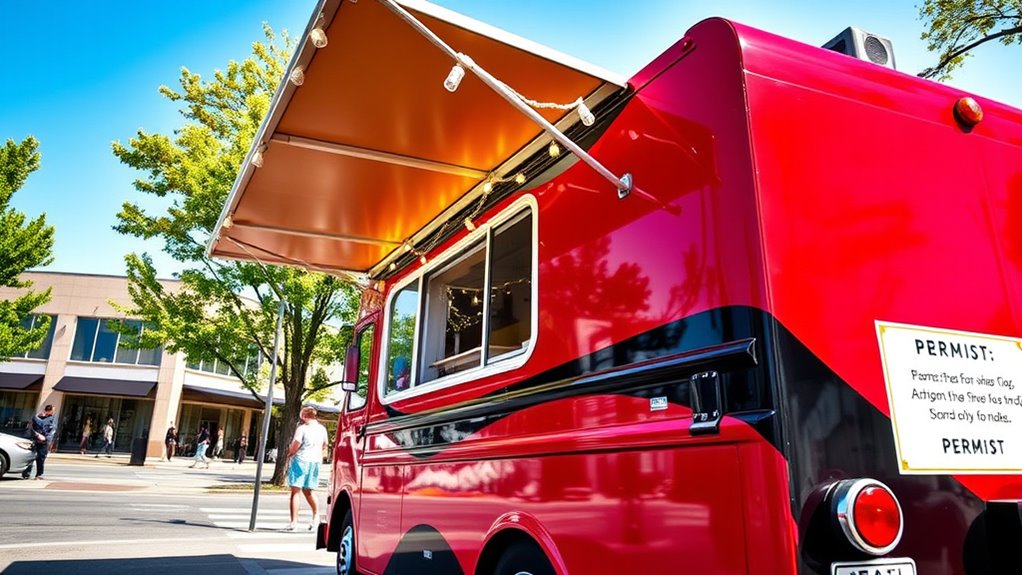
Getting your food truck permit is the essential first step before hitting the streets of Arlington, TX. To start, you need to understand the specific food truck permits required by local authorities. These permits ensure your truck complies with health, safety, and zoning standards. You’ll want to research Arlington’s local requirements early to avoid delays later. Applying for the right permits involves submitting detailed documentation about your truck, menu, and business operations. Keep in mind that permits may need renewal periodically, so staying organized from the start is key. Securing your food truck permits not only keeps you compliant but also builds trust with your customers. Once you have these permits in hand, you’re ready to move on to the next steps of launching your food truck business. Organized documentation is crucial in streamlining the application process and maintaining compliance over time.
Understanding Local Requirements

To get started, you’ll need to navigate Arlington’s online permit application portals to guarantee you meet all legal requirements. Make sure you understand sanitation standards and gather the necessary documentation to avoid delays. Additionally, familiarize yourself with designated street vending zones to plan your setup accordingly.
Online Permit Application Portals
Exploring Arlington’s permit application process is straightforward thanks to its user-friendly online portals. You can easily submit all necessary documents and applications through these digital platforms, saving you time and effort. The portals are designed to guide you step-by-step, ensuring you meet local requirements efficiently. Once your permits are approved, you can focus on marketing your food truck using digital marketing strategies and social media. These tools are essential for building your customer base and promoting your menu. By accessing Arlington’s online portals, you also stay updated on any changes to regulations or renewal deadlines. Overall, the digital approach simplifies the permit process and helps you get your food truck on the road faster, giving you more time to grow your business.
Sanitation Standards and Documentation
Understanding Arlington’s sanitation standards is essential to guarantee your food truck meets local health requirements. To ensure food safety and proper sanitation procedures, you should focus on these key points:
- Keep detailed records of all cleaning and sanitation practices.
- Regularly sanitize all food contact surfaces and equipment.
- Maintain proper storage of cleaning chemicals, away from food.
- Complete necessary documentation, such as health inspections and certifications, to demonstrate compliance.
Following these steps helps you avoid violations and promotes a safe environment for your customers. Arlington’s health department may require specific forms or procedures, so stay updated on local documentation demands. Prioritizing sanitation standards not only protects public health but also boosts your reputation as a responsible food truck operator.
Designated Street Vending Zones
Knowing where you can legally set up your food truck is essential for avoiding fines and ensuring smooth operations. Arlington has designated street vending zones to help you comply with local regulations. These zones are specific areas where parking enforcement allows food trucks to operate without penalties. Before setting up, you must complete your vendor registration and obtain necessary permits for these zones. Parking enforcement officers monitor these areas closely, so adhering to the designated zones prevents citations. Make sure to check Arlington’s official zoning maps and guidelines to identify approved vending spots. By doing so, you’ll stay compliant with local laws, avoid unnecessary fines, and build a positive reputation within the community. Always stay updated on any changes to vending zones to ensure continued smooth operation.
Setting Up Your Base of Operations
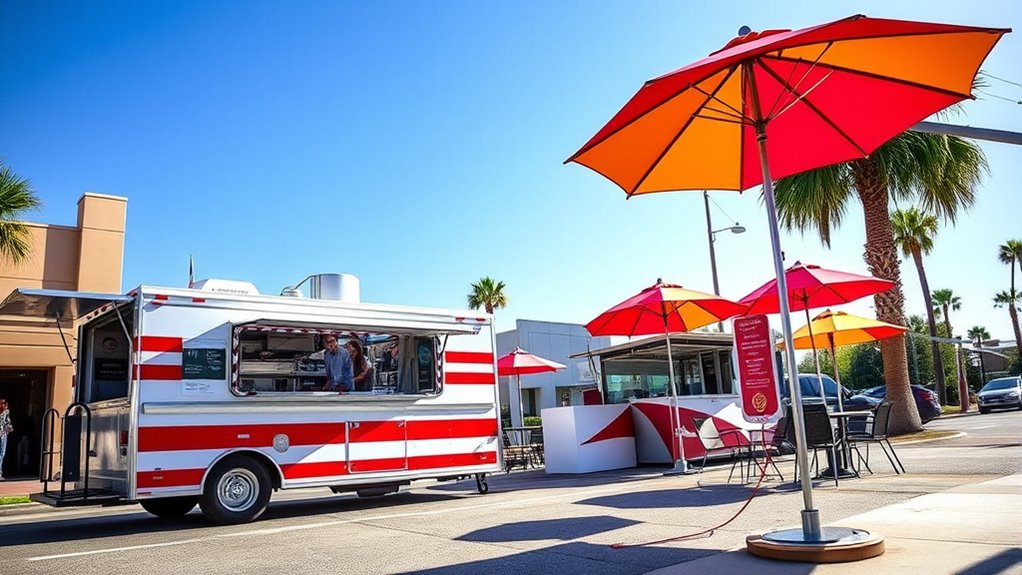
Choosing the right space is vital when setting up your food truck’s base of operations. Shared kitchen licensing options can save you money and simplify compliance, while custom kitchen layouts make certain your space fits your specific needs. Consider these factors carefully to create an efficient and legal foundation for your food truck business. Additionally, understanding local building codes and permit requirements ensures safety and legality throughout the setup process.
Shared Kitchen Licensing Options
Setting up your food truck operation often involves selecting a shared kitchen license, which can be a cost-effective way to meet health department requirements without building your own facility. Shared kitchen licensing offers flexibility and simplifies compliance with co-working kitchen regulations. Here’s what you need to consider:
- Verify that the facility has proper licensing for shared kitchen licensing.
- Ensure the space meets health and safety standards required by Arlington, TX.
- Confirm your specific food prep activities are allowed within the shared kitchen.
- Understand the terms of use, including hours and cost, to fit your schedule and budget.
Choosing a shared kitchen not only streamlines licensing but also helps you avoid hefty overhead costs, making it an ideal base of operations for your food truck.
Custom Kitchen Layout Planning
Designing a custom kitchen layout is an essential step in establishing an efficient and functional food truck. Focus on kitchen ergonomics to ensure smooth workflows and reduce fatigue during busy hours. A well-thought-out layout optimization helps you maximize limited space, making every inch count. Place frequently used equipment, like prep stations and cooking appliances, within easy reach to speed up service. Consider traffic flow, so staff can move comfortably without congestion. Incorporate proper storage solutions for ingredients and utensils to keep the workspace organized. By paying attention to these details, you’ll create a kitchen that promotes safety, efficiency, and productivity—key ingredients for a successful food truck operation in Arlington, TX.
Budgeting and Financing Your Food Truck

To get your food truck up and running, you’ll need to plan for initial equipment costs and explore local small business grants that can help ease expenses. Make sure to also budget for liability coverage to protect your business and assets. Understanding these financial aspects will set a solid foundation for your food truck journey in Arlington. Additionally, being aware of potential regulatory compliance challenges can help you navigate legal requirements smoothly and avoid costly penalties.
Initial Equipment Purchase Costs
Budgeting for your food truck’s initial equipment is a crucial step that directly impacts your startup costs. Your purchase costs for essential equipment can vary, but understanding the main expenses helps you stay on track. Consider these key items:
- Commercial kitchen appliances (stoves, ovens, refrigerators)
- Food prep tools and utensils
- Serving and storage equipment
- Point-of-sale systems and signage
These initial equipment costs can range from $20,000 to $50,000 depending on quality and scale. By carefully estimating these purchase costs, you can create a realistic budget and identify financing options. Remember, investing in durable, high-quality equipment upfront saves you money in the long run, ensuring your food truck runs smoothly from day one.
Local Small Business Grants
Securing local small business grants can provide a vital funding source to help cover your food truck startup costs in Arlington, TX. These grants, offered by city agencies or community organizations, can supplement your financing efforts without adding debt. To access small business funding, research local programs that support entrepreneurs in the food industry or small business development. Applying for grants typically involves submitting a detailed business plan, showcasing your community impact, and demonstrating financial need. Keep in mind, grants are competitive, so tailor your application to highlight how your food truck will benefit Arlington’s local economy. By leveraging local business grants, you can reduce upfront costs and strengthen your financial position as you launch your food truck venture.
Liability Coverage for Food Trucks
Since liability coverage is essential for protecting your food truck business, understanding its role in your overall budgeting and financing plan is critical. Liability insurance is a key component of risk management, shielding you from unexpected costs. To make informed decisions, consider these points:
- Determine the minimum liability coverage required by local regulations.
- Budget for comprehensive liability insurance to protect against accidents or injuries.
- Assess potential risks, like property damage or customer injuries, to decide appropriate coverage levels.
- Incorporate liability insurance costs into your overall startup expenses to ensure financial stability.
Designing Your Menu and Pricing Strategy

To create an appealing menu, focus on incorporating local flavors that resonate with Arlington residents. Keep your costs in check by analyzing portion sizes carefully, ensuring you offer value without overspending. Balancing unique dishes with strategic pricing will help attract customers and boost your profits. Additionally, understanding grocery savings strategies can help you reduce ingredient costs while maintaining quality.
Local Flavor Integration Techniques
Incorporating local flavors into your menu can set your food truck apart and attract a dedicated customer base in Arlington, TX. To achieve this, focus on regional flavor fusion by sourcing local ingredients that highlight Arlington’s unique culinary culture. Here are four techniques to help you succeed:
- Local Ingredient Sourcing: Partner with local farms and markets to get fresh, regional ingredients that add authenticity.
- Signature Dishes: Create menu items that blend popular local flavors with your culinary style.
- Seasonal Offerings: Adjust your menu seasonally to incorporate fresh, regional produce, keeping your offerings exciting.
- Community Engagement: Feature local specialties and participate in community events to strengthen your connection with Arlington’s food scene.
These strategies will help you craft a menu that resonates with locals and celebrates Arlington’s regional flavor fusion.
Cost Control Through Portion Analysis
Effective portion analysis is essential for controlling costs and maximizing profit margins when designing your food truck menu. By carefully evaluating portion sizing, you can prevent waste and ensure each dish contributes to your bottom line. Conducting a thorough cost analysis helps you determine the ideal portion sizes that balance customer satisfaction with profitability. Adjusting portion sizes based on ingredient costs and customer demand allows you to set competitive prices while maintaining healthy profit margins. Consistently monitoring and refining your portion analysis ensures you stay on top of ingredient usage and avoid over-serving. This strategic approach to portion sizing keeps your food costs in check, making your menu both appealing to customers and financially sustainable.
Technology and Operations
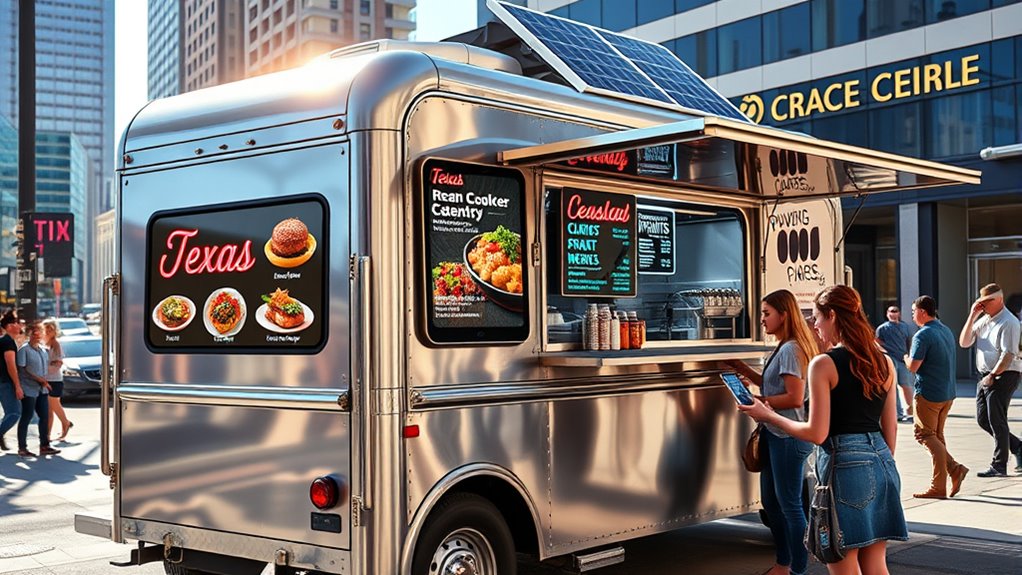
Using mobile card readers and apps can streamline your sales process and reduce wait times. Real-time inventory tracking keeps you informed about stock levels, helping you avoid shortages. Incorporating these tools makes your operations more efficient and lets you focus on serving great food.
Mobile Card Readers and Apps
Mobile card readers and apps are essential tools for streamlining transactions and enhancing customer experience at your food truck. They make accepting cashless payments quick and easy, helping you serve more customers efficiently. Here are four key benefits:
- Simplifies payments with mobile payment apps, reducing wait times.
- Increases sales by offering multiple payment options.
- Improves accuracy by minimizing cash handling errors.
- Boosts customer satisfaction through fast, contactless transactions.
Real-time Inventory Tracking Software
Integrating real-time inventory tracking software into your food truck operations guarantees you stay on top of stock levels without constant manual checks. With effective inventory management, you can monitor ingredients and supplies as they’re used, reducing waste and preventing shortages. This technology provides instant updates, so you know exactly what’s available, what needs restocking, and when to order more. Stock tracking becomes seamless, allowing you to optimize your purchasing decisions and keep your menu running smoothly. Plus, real-time data helps you identify popular items and adjust inventory accordingly. By adopting this software, you streamline operations, save time, and avoid costly mistakes. Overall, real-time inventory management is essential for maintaining a well-organized, efficient food truck business in Arlington, TX.
Marketing and Growing Your Presence

To boost your food truck’s visibility, plan your weekly events carefully to attract consistent crowds. Posting eye-catching food photos on Instagram helps you engage your audience and build a loyal following. With the right strategy, you’ll see your presence grow quickly in Arlington’s vibrant food scene. Additionally, understanding WWE Raw’s Financial Impact can inspire creative promotions that draw in diverse audiences and increase your revenue.
Weekly Event Scheduling Tips
Scheduling your weekly events strategically can substantially boost your food truck’s visibility and customer base. To maximize impact, consider these tips:
- Pick consistent days and times to build customer habits.
- Use seasonal menu planning to tailor offerings to upcoming events, increasing appeal.
- Promote each event with targeted strategies, like social media posts and local partnerships.
- Reserve special menu items or discounts to create buzz and encourage repeat visits.
Engaging Instagram Food Photos
Capturing eye-catching Instagram food photos can substantially boost your food truck’s visibility and attract new customers. Focus on food styling to make each dish look irresistible—use vibrant colors, appealing garnishes, and clean presentation. Pay attention to photo composition by choosing angles that highlight textures and details, such as overhead shots or close-ups. Good lighting is essential; natural light works best, so shoot outside when possible. Keep backgrounds simple to guarantee the food remains the focal point. Editing can enhance your photos, but avoid overdoing filters. Consistency in your style and posting schedule helps build your brand. Engaging, high-quality images will entice followers to visit your truck, ultimately increasing your customer base.
Navigating Arlington’s Vibrant Food Scene
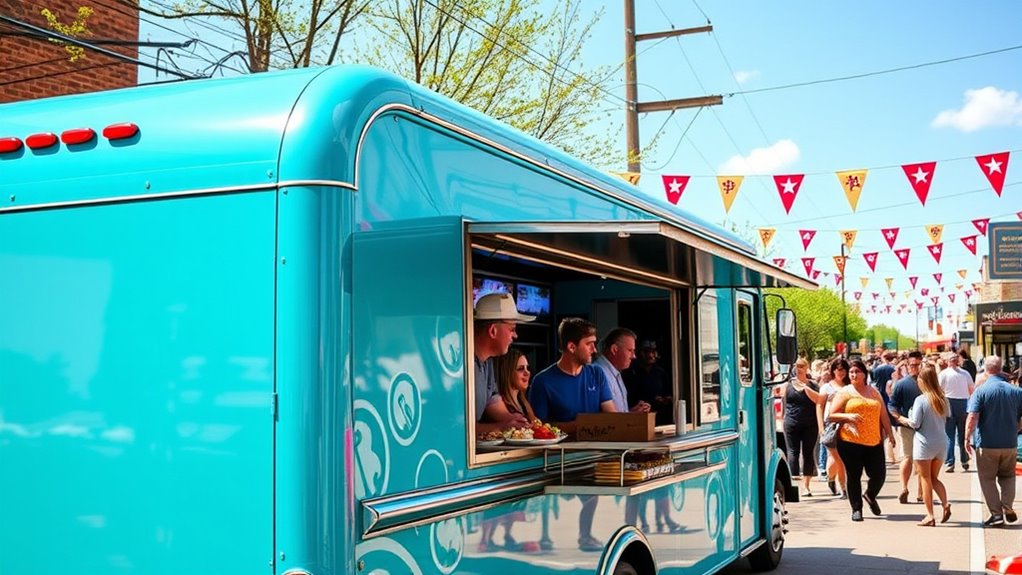
Exploring Arlington’s vibrant food scene can be both exciting and rewarding for new food truck owners. To stand out, focus on:
- Food truck branding — develop a memorable logo and truck design that reflect your cuisine.
- Location scouting — find high-traffic spots like downtown events or busy markets.
- Customer engagement — build relationships through friendly service and social media interaction.
- Menu innovation — keep your offerings fresh and unique to attract repeat customers.
Frequently Asked Questions
What Permits Are Required for Alcohol Sales on a Food Truck in Arlington?
You need to obtain alcohol licensing and beverage permits to sell alcohol on your food truck in Arlington. First, apply through the Texas Alcoholic Beverage Commission (TABC) to secure the proper alcohol license. You’ll also need a local permit from Arlington’s city authorities. Make sure to adhere to all regulations, including checking ID and serving responsibly, to ensure legal and successful alcohol sales on your food truck.
How Do I Find Reliable Suppliers for Food Truck Ingredients Locally?
Think of sourcing ingredients as steering through a vibrant marketplace. You’ll want to seek out reliable local produce vendors and wholesale distributors who grow or supply fresh, quality ingredients. Visit farmers’ markets, attend local food events, and ask fellow food truck owners for recommendations. Building relationships with these suppliers ensures you get fresh, consistent ingredients, turning your menu into a flavorful journey that keeps customers coming back for more.
Are There Specific Health Codes Unique to Arlington’s Food Trucks?
In Arlington, food truck safety is guided by city-specific health codes, so you’ll need to abide by Arlington health inspections. These codes include requirements for proper food handling, sanitation, and equipment. To guarantee compliance, regularly review Arlington’s health department guidelines and schedule inspections. Staying informed about any updates helps you meet local standards, making your food truck safe for customers and avoiding any penalties during Arlington health inspections.
What Are the Best Times and Locations for Food Truck Events in Arlington?
You should target food truck festivals and peak dining hours, typically lunch and dinner times, to maximize your sales in Arlington. Attend popular events like the Arlington Foodie Fest or local farmers markets, which draw large crowds. Position your truck near busy parks, office complexes, or entertainment venues during these times. By choosing prime locations during high-traffic periods, you’ll boost visibility and attract more customers efficiently.
How Can I Partner With Local Businesses for Catering Opportunities?
Imagine your food truck as a bridge connecting flavors and local businesses. To forge strong partnerships, actively seek out community engagement opportunities by visiting local shops and attending networking events. Use cross promotion strategies like offering exclusive catering menus or joint marketing efforts. By building genuine relationships, you transform your truck into a crucial part of Arlington’s vibrant community, opening doors to steady catering opportunities and mutual growth.
Conclusion
Starting your food truck in Arlington, TX, is an exciting venture. Did you know the city hosts over 1,000 food trucks, making it a bustling hub for mobile dining? With the right permits, a solid plan, and a unique menu, you can stand out and thrive. Keep focused on your goals, embrace Arlington’s vibrant food scene, and watch your business grow. Your food truck dream is just around the corner—get started today!
